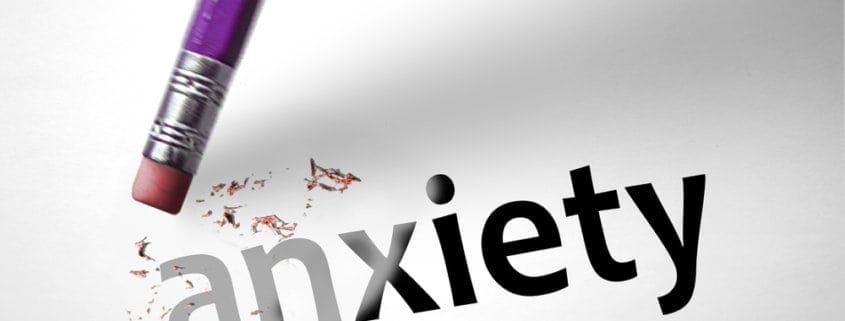Calming the Anxiety Storm
One of the most common questions that people have is how to effectively manage anxiety. The nervous thoughts are bad enough, but the physical symptoms only make things worse as people start to worry that others can see them shaking or trembling, that their face is noticeably red, or that sweat is forming the dreaded armpit stain on clothing.
How to Effectively Manage Anxiety: Simple Techniques to Calm the Storm
There are dozens of types of anxiety, but all of them are related to the sympathetic nervous system’s alert mechanism of Fight, Flight, or Freeze. Fortunately, there are very specific skills that you can learn to calm the storm, or at least make it more manageable while you get those skills dialed in better.
Techniques for Calming Anxiety
Let’s discuss the basics of anxiety management. Here are a few terms to become familiar with:
- Mindfulness: quite simply, noticing what is, but without judging it as
- Breathing: proper belly breathing turns down the fight-or-flight mechanism
- Meditation: a mindfulness practice involving noticing simply what is, while anchored in the breath
- Cognitive-behavioral practices: the use of new thoughts (cognitions) to guide new behaviors that lead to new results that feedback to the conscious and unconscious minds to change our lives
Mindfulness: Notice What You Are Feeling
Please read this post on mindfulness for greater detail. To summarize though, mindfulness is about noticing what is going on inside of you, and around you, without judging it as good or bad. You may experience thoughts of ‘good’ or ‘bad’ but with mindfulness, you simply see those as thoughts and shift your focus to what the discomfort is trying to tell you (like removing your hand from the hot stove to prevent further burning).
Also, remember that mindfulness is also about noticing wonderful things without judgment. Of course, enjoying your experience is okay! And if you’re going to judge something as ‘good or bad,’ recognizing and celebrating goodness is a great way to do it!
Breathing: Initiate the “Relaxation Response”
Reading this post on meditation will help with this section and the next one.
When you breathe from your belly, where the belly expands on the inhale, you are breathing as you do in your most relaxed state of sleep. This kind of smooth, rhythmic breathing stimulates a neurological process called the relaxation response that slows brainwaves and triggers the release of endorphins that calm the body. It takes practice to become proficient with it and to notice the benefits; however, biofeedback can show that the body is responding even if you do not consciously notice it. Keep going.
To learn this technique, lie down, place a pillow under your knees, and put your hands on your belly. Close your eyes if you like. Now breathe so that your belly inflates and lifts your hands. When you exhale, allow your belly to sink back into your body (you don’t have to ‘suck it in’).
3 Simple Tools to Manage Stress
Stress is an unavoidable part of life, but it doesn’t have to overwhelm us. Here are three simple tools you can use to manage stress:
- Breathing: Slow, deep breathing is an effective way to calm the body and reduce stress. Try taking a few deep breaths, inhaling through your nose, and exhaling through your mouth. While there are specific breathing patterns, for now just go with slow-ish, smooth, and rhythmic. Elevating your feet helps calm anxiety as well, so feel free to do this as well while you breathe.
- Meditation: Bringing together mindfulness and breathing, meditation is about being completely aware of the mind while in a flow state that is induced with smooth, gentle diaphragmatic (belly) breathing. Simply sit comfortably or lie down, breathe, and notice the antics of the mind. If you find yourself judging your thoughts or feelings, just notice the judging then return to your gentle breathing. Meditation is not about perfection, but rather about allowing imperfection to happen and learning to shift your focus back to the gentle breath. Read the article on meditation for more details.
- Cognitive-Behavioral Practice: Mindfulness meditation creates a fertile ground for changing thoughts and behaviors that shape your life. As you become mindful of your thoughts and feelings, you can identify the ones that create problems and suffering. With this done, you can intervene by training your brain to use new thoughts (cognitions) to direct new behaviors. Changing thoughts change behaviors, which changes results that shape your life.
For more information on Anxiety, please visit the MedLine Plus website article about anxiety.
Learn more about Counseling for Anxiety in Austin.
Jonathan F. Anderson, LPC-s has worked in the helping profession since he started college in 1990. After completing his Bachelor’s degree at the University of Texas, Austin in 1994, he attended the highly-regarded University of Minnesota to earn his Master’s degree in 1997. He is a Licensed Professional Counselor and is recognized as a Board Approved Supervisor by the State of Texas Board of Examiners of Professional Counselors. Jonathan has completed Level 2 of the Gottman Method of Couples Counseling, and in 1998 received training from the International Critical Incident Stress Foundation in Advanced Critical Incident Stress Management & Debriefing. To learn more about Jonathan’s practice, click here: Jonathan F. Anderson, LPC-s.



